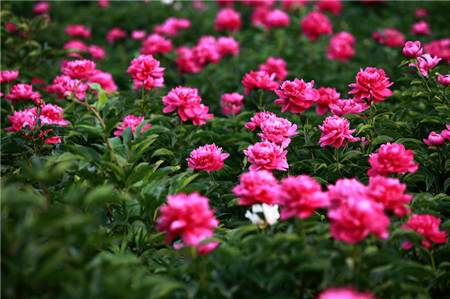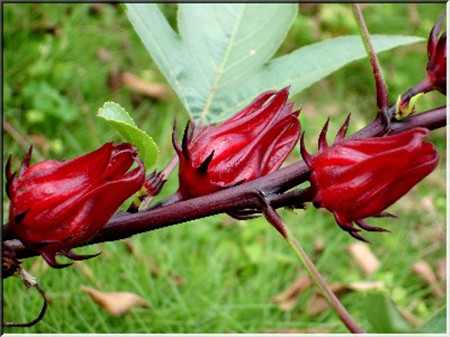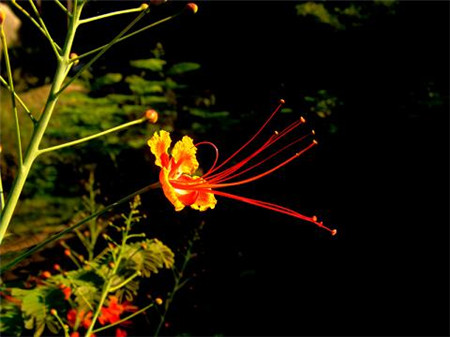Matters needing attention in planting Paeonia lactiflora
Paeonia lactiflora is native to northern China and belongs to perennial root flowers. now there are more than a thousand varieties in the world, and there are about 180 species in China. Paeonia lactiflora has strong adaptability and cold tolerance, and it can overwinter in open field in the north of China. At present, wild species are distributed in Qinling Mountains, Dabie Mountains and other places, but three points should be paid attention to in the cultivation of peony flowers.
-, soil
Good drainage, peony like cool climate, China's temperate zone to subtropical areas are suitable for cultivation, with spring sprouting, autumn rooting characteristics, in summer. In the hot and hot season, the plant is semi-dormant, like sandy loam with loose fertility and good drainage, and avoid saline-alkali soil. Because peony is a fleshy root, it is resistant to drought but afraid of stagnant water, such as soil consolidation and stagnant water, it is easy to make peony fleshy root rot, so lowland and saline-alkali land are not suitable for cultivation.
Therefore, the ground planting should choose cool and sunny places, pot planting avoid watering too much. The whole dormant period from winter to early spring, the soil should be kept moist, not too dry, but the drainage should be smooth, avoid stagnant water, otherwise the underground root is easy to rot to death.

Ramet, ramet
Paeonia lactiflora was propagated by ramets. As the saying goes, "the Spring Equinox divides the peony, but does not blossom when he is old", so the peony is usually divided in October after its aboveground part has withered, and it is not suitable to be transplanted in spring. When ramet, dig out the root plant, cut it along the root crack with a sharp knife, so that each clump has 3 to 5 full buds and the root group below, do not hurt the bud eye, and then plant it in the sandy soil with basic fertilizer, cover the soil 3 to 4 cm, keep the soil moist and unsoiled, and blossom every year after planting.
Potted peony can be combined with ramet-two years to change the pot, and more persistent soil should be retained when changing the pot. If the bushes are small, do not split.
III. Florescence
Paeonia lactiflora can not be short of water during the plant growth period, especially in the bud stage and flowering stage. At the same time, the buds should be thinned in time, and the lateral buds should be removed after they appear, so as to concentrate nutrients and make the top buds bigger. After the flowers withered, the pedicels should be cut off in time so as not to seed and consume nutrients.
Half a month after the blooming of peony, that is, late June, fertilization should be carried out to supplement the nutrients consumed in the flowering period of peony in time, so as to lay a good foundation for peony to enter the first vigorous growth period.
Methods of Paeonia lactiflora culture points for attention in planting Paeonia lactiflora
Paeonia lactiflora is a flower plant with a long history of cultivation, which is very similar to the common peony flowers in our daily life. Very often, peony and peony flowers are planted together to improve ornamental. So how to raise peony flowers? Let's take a look at the breeding methods and matters needing attention of peony.
Brief introduction of Paeonia lactiflora
Paeonia lactiflora, alias general from grass, belongs to Saxifraga, Ranunculaceae Paeonia lactiflora belongs to perennial herbaceous flowers. Peony is known as "flower immortal" and "flower phase", and is listed as one of the "six famous flowers", also known as "Mayflower God". Because it has been regarded as the flower of love since ancient times, it has been regarded as the representative flower of Qixi Festival. Paeonia lactiflora is a traditional famous flower in China, which is resistant to cold, likes cold climate, is not resistant to water and moisture, and is as famous as peony, the king of flowers.
How to raise peony flowers:
Paeonia lactiflora is cold-resistant, like fertilizer and afraid of waterlogging, like soil moisture, but also resistant to drought, sunshine and cool climate in summer. Potted peony is easy to scorch leaves under the scorching sun in midsummer, so you should pay attention to shading. Paeonia lactiflora is a fleshy root with a long root system, so it should be planted in sandy loam with fertile, loose and well-drained soil and perishable roots in clay and low-lying stagnant water.
Culture methods of Paeonia lactiflora
1. Planting time of Paeonia lactiflora: Paeonia lactiflora likes sunshine and cold tolerance, and it should be cool and afraid of heat when the temperature is high, and it does not grow well at high temperature in summer. Autumn is the best time to plant peony.
2. Soil quality: when planting peony, you should choose sunny land with high topography and good drainage, and do not plant it in low-lying places where it is easy to accumulate water. Paeonia lactiflora is a fleshy root, so we should choose loose, fertile and slightly acidic sandy soil when planting. It is not suitable to grow in alkaline soil. If the soil is too alkaline, it will cause leaf yellowing, even atrophy and death.
3. Main points of cultivation: when cultivated in open field, manure should be applied to turn the stables deeply, and the beds should be arranged after fining. Generally, the height of the border is 10-15 cm, the width of the border is 70 cm, and the length is unlimited. The distance between cultivated plants is 80 cm. During cultivation, dig holes according to the length and size of the root system, pay attention to the root should be extended, should not be too deep, cover the soil to cover the top bud 4cm for the degree, after planting, pour water once, choked soil overwintering.
4. Fertilizer and water management: peony does not need to be watered frequently except for natural precipitation. Usually only in the most water demand before and after flowering and in case of spring drought before and after appropriate watering, in order to supplement the lack of soil moisture, each watering should not be too much. Topdressing should be controlled, three times a year, and the first time it is quickly drawn out in the new shoots. When the leaves and buds are stretching, they mainly apply quick-acting fertilizer, which is called flower-promoting fertilizer.
5. Shaping and pruning: in order to make peony flowers colorful and robust, shaping and pruning is very important. Peony plastic surgery mainly includes fixing stem, pruning, removing buds, thinning buds, cutting off residual flowers and so on. Paeonia lactiflora can be dried after 2-3 years. For the varieties with strong growth potential and exuberant growth, they can be pruned into independent peony. For the varieties with weak growth potential and small number of branches, the thin and weak branches are generally cut off and the strong branches are retained.
6. pest control: the common diseases and insect pests of peony are brown spot, anthrax, rust, root rot and root nodule nematode disease, longicorn beetle, red spider, beetle, mole cricket and so on. The prevention and control of diseases and insect pests should give priority to early prevention, once diseases and insect pests occur. According to the degree of occurrence, according to the above-mentioned dosage, the interval between spraying should be appropriately shortened and the frequency of drug use should be increased.
Points for attention in planting Paeonia lactiflora
Paeonia lactiflora can not be transplanted frequently after planting, otherwise it will damage the root and affect the growth and flowering. In order to make the peony grow well, reasonable fertilization is needed every year. After each fertilization, enough water should be irrigated, and the soil should be loosened immediately to reduce water evaporation. Weeding should be often ploughed in the rainy season.
After potted peony, Frosts Descent cut off the withered branches and leaves to prevent the breeding of diseases and insect pests. During the overwintering period, there is no need to move indoors, put it on the balcony or under the eaves where there is plenty of sunshine, and the basin soil should not be too dry.
Before the peony blossoms, after the lateral buds appear, they can be removed in time to concentrate nutrients and promote the beauty of the top bud flowers. After the flower fades, if you do not plan to sow and reproduce, you should cut off the pedicel at any time so as not to seed and consume nutrients.
The above is the introduction of the culture methods of peony. I hope the above content will be helpful for everyone to understand and understand the culture methods and matters needing attention of peony. We can all understand how to raise peony flowers and cultivate beautiful peony flowers at home.
Introduction of peony flower planting technology and matters needing attention!
Peony is known as "flower immortal" and "flower phase", and is listed as one of the "six famous flowers", also known as "Mayflower God". Because it has been regarded as the flower of love since ancient times, it has been regarded as the representative flower of Qixi Festival. In addition, peony is an important flower in A Dream of Red Mansions, and Shi Xiangyun is one of the most beautiful scenes in A Dream of Red Mansions. Today, I would like to briefly introduce the planting technology of Paeonia lactiflora and related matters needing attention. Planting techniques of Paeonia lactiflora: split planting is the most commonly used in peony planting methods. Seedling production in peony producing areas is basically propagated by this method. It has three advantages: first, it blossoms earlier than sowing method, sowing seedlings blossom in 4-5 years, and ramet seedlings can blossom every other year; second, ramet operation is simple and easy, labor-saving management is conducive to wide application; third, it can maintain the good characters of the original varieties. The disadvantage is that the reproduction coefficient is low, and the three-year-old mother plant can only be divided into 5 sub-plants, which is difficult to adapt to and meet the needs of modern large-scale production and the rapid growth of domestic and foreign flower markets. Sowing and planting: sowing is also a kind of peony planting, sowing and planting land should be fully fertilized, and if the soil is more moist and suitable for sowing, you can do border sowing directly; if the soil moisture is poor, you should fully irrigate, and then do border sowing. The width of the border is about 50 cm, the distance between the borders is 30 cm, and the seeds are sown according to row spacing of 6 cm and seed spacing of 3 cm. If the seeds are sufficient, the seed spacing is not less than 3 cm, and the seed spacing is not less than 3 cm. After sowing, it is covered with wet soil with a thickness of about 2 cm. Cover with plastic film after sowing, sprout and unearth in the following spring and then withdraw. Then rake it flat before sprouting in the following spring. Cutting planting: if the planting method of cutting peony is adopted, the nursery with high terrain and good drainage should be selected as the cutting bed. After the bed soil is loosened, 15 cm thick river sand should be covered, and the river sand should be disinfected with 0.5% potassium permanganate. The cutting substrate can also be vermiculite or perlite. Build a 1.5-meter-high sunshade on the bed. According to the experience of Changchun and other places, the effect of cutting cuttings in mid-July is the best. After taking root, the amount of water spraying and watering should be reduced, and the plastic shed and sunshade should be removed gradually. The cuttings grow slowly and need to be covered with soil on the bed to survive the winter, and then moved to the open field for planting the following spring. Matters needing attention in the cultivation of peony flowers the main diseases of peony flowers are peony red spot, peony rust and so on. At the initial stage of peony rust symptoms, there are small yellow particles on the back of leaves, that is, the summer spore pile of pathogens. In the later stage, round, oval or irregular grayish brown spots appeared on the leaf surface, its diameter was 4-12mm, and there were wheel lines and small spots on the spot. Cylindrical reddish-brown bristles grow in the summer spore pile on the back of the leaf, growing 1-1.5mm, which is the winter spore pile of the pathogen. The main pests of Paeonia lactiflora are shell insects, aphids and so on. Scale insects, also known as scale, there are many kinds of scale insects that harm peony. The shell insects absorb the body fluid of peony, which weakens the plant growth and turns the branches and leaves yellow. When it is found that individual branches are damaged by shell insects, they can be brushed off with a soft brush, or cut off and burned, and spray during the incubation period of the eggs. The newly hatched insect body is not covered with wax and is easy to be killed. It is best to strengthen quarantine and strictly prevent the introduction of insect-carrying seedlings. When peony germinates in spring, aphids will fly to harm the growth of peony, suck the juice of leaves and make the affected leaves curl and turn yellow. after the seedlings grow up, aphids often gather in tender shoots, pedicels, leaf backs and other places, so that the stems and leaves of flowers and seedlings curl and shrink, so that the whole plant withered and died. Spraying 40% dimethoate emulsion 1000 / 1500 times, or 80% dichlorvos 1500 / 1500 times, or 50% aphid pine emulsion 1000 / 1500 times could inhibit aphid damage in a short time.
- Prev

The growing environment of Luoshenhua
Luoshenhua (Roselle) is a tropical and subtropical short-day crop, which likes light, temperature and avoid early frost. it grows best under the condition of 25 ~ 30 degrees Celsius. Paluoshenhua (Roselle) was sown from March to May and harvested from September to November with a full growth period of 160-200 days.
- Next

Cultivation and Management of Phoenix Flower (Phoenix Tree)
Phoenix flower (Phoenix flower) is light-loving and not cold-resistant, grows rapidly, has well-developed roots, and has poor resistance to smoke and dust. Native to Madagascar, it is often cultivated in tropical areas of the world and cultivated in Yunnan, Guangxi, Guangdong, Fujian, Taiwan and other provinces of China. Propagation methods-sowing and propagation are used as many as possible, and fruits are harvested and exposed to the sun.
Related
- Fuxing push coffee new agricultural production and marketing class: lack of small-scale processing plants
- Jujube rice field leisure farm deep ploughing Yilan for five years to create a space for organic food and play
- Nongyu Farm-A trial of organic papaya for brave women with advanced technology
- Four points for attention in the prevention and control of diseases and insect pests of edible fungi
- How to add nutrient solution to Edible Fungi
- Is there any good way to control edible fungus mites?
- Open Inoculation Technology of Edible Fungi
- Is there any clever way to use fertilizer for edible fungus in winter?
- What agents are used to kill the pathogens of edible fungi in the mushroom shed?
- Rapid drying of Edible Fungi

